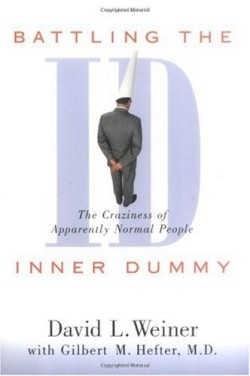Battling the Inner Dummy
The Craziness of Apparently Normal People
Forget the devil. Blame the brain.
That’s what business consultant and popular psychology writer Weiner might say to those who wonder what makes a normal person occasionally act more like a caveman than a sane man.
Whether it’s a fit of road rage or a fling in the Oval Office, everyone is susceptible, according to Weiner. That’s because the human brain is composed of two operating systems; the rational part known as the cerebral cortex, which covers the primitive, other part, the limbic system. Freud called the limbic system the “id”; Weiner renames it “The Inner Dummy” for the sound-bite generation. The Inner Dummy is, in effect, a cauldron for the instinctive drives—power, sex, territory, nurture, survival—which at their most intense provided a great survival kit for our primitive ancestors. Yet the Inner Dummy lives on, impervious to time, logic and awareness of the need for civility, revealing itself in irrational acts of rage, revenge and fear during divorces, power struggles at work and refusals to ride in elevators.
Believing the uncontrolled Inner Dummy to be “the greatest problem we have as humans,” Weiner offers “a primer for allowing people to function in a civilized manner.” His audience is the general public whom he hopes might “develop insights into the causes of [such] irrationalities” and “seek out strategies for sidestepping them” by controlling, not stifling, emotions.
Weiner’s breezy first-person style works well when explaining the background of evolutionary psychology, in which he skillfully interweaves quotes from his sources. He is equally effective in providing lively examples when describing the various limbic drives. For example, his friend’s germ phobia is used to demonstrate the irrationalities of the survival drive, preventing him from eating a steak if he thinks a drop of sweat from the chef’s brow might have fallen onto his food.
Other highlights include scales for readers to test their limbic drive intensities, and an essential overview on ways people might overrule or outsmart their own Inner Dummy through methods as diverse as therapy, psychotropic drugs or holistic approaches. Less effective are his chapter interludes in which Sigmund Freud is transposed from the dead to serve as a consultant for an ad agency looking to develop an Inner Dummy campaign.
The book inadvertently raises questions about the nature of responsibility in a culture eager to assign blame. Also troubling is the need to dummy down perfectly functional metaphors—Freud’s “id” and science’s limbic theory—into one presumably more understandable to the masses.
By saying Weiner’s Inner Dummy concept is the same old mind in a new boggle is not to diminish its effectiveness. Often a new way of seeing an old problem is just what is needed to capture the mind’s eye and bring about positive change.
Reviewed by
Judy Hopkins
Disclosure: This article is not an endorsement, but a review. The publisher of this book provided free copies of the book to have their book reviewed by a professional reviewer. No fee was paid by the publisher for this review. Foreword Reviews only recommends books that we love. Foreword Magazine, Inc. is disclosing this in accordance with the Federal Trade Commission’s 16 CFR, Part 255.

